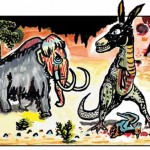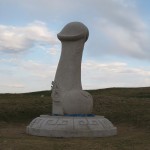Neo-Paganism is a nature religion which, like other nature religions, perceives nature as both sacred and interconnected. From this perspective, humans in the developed world have become tragically disconnected from nature, which has been desacralized in both thought and deed. Healing this rift is possible only through a profound shift in our collective consciousness. This constellation of ideas can be called “Deep Ecology”. This is the fifth in a 6-part series about some of “branches” of Deep Ecology. This essay was originally published at Neo-Paganism.com.

In 1967, Lynn White published an article in the periodical Science entitled “The Historical Roots of Our Ecological Crisis”. The article examined the influence of Christianity on humankind’s relationship with nature. White believed that the environmental decline was, at its root, a religious problem, specifically a Christian problem. White marked the Industrial Revolution as the fundamental turning point in our ecological history, when our ability to destroy nature grew exponentially. However, for White, the belief that the earth was a resource for human consumption was much older and could be traced back to the triumph of medieval Christianity over pagan animism, and even further back to the Biblical injunction to man to “subdue” the earth and exercise “dominion” over every living thing. Medieval Christianity, according to White, elevated humankind, who was made in God’s image, and denigrated the rest of creation, which was believed to have no soul.
“In antiquity every tree, every spring, every stream, every hill had its own genius loci, its guardian spirit. … Before one cut a tree, mined a mountain, or dammed a brook, it was important to placate the spirit in charge of the particular situation, and keep it placated. By destroying pagan animism, Christianity made it possible to exploit nature in a mood of indifference to the feel in of natural objects. … Man’s effective monopoly on spirit in this world was confirmed, and the old inhibitions to the exploitation of nature crumbled.”
White argued that what was needed to avoid environmental catastrophe was a change in religious perspective. He suggested St. Francis of Assisi’s model of a “democracy of creation” in which all creatures are respected and humankind’s dominion is circumscribed.
In 1972, five years after White published his article, Arnold Toynbee published “The Religious Background of the Present Environmental Crisis”. Similar to White, Toynbee traced the cause of environmental destruction to monotheism, to which he contrasted the ancient pagan attitude toward nature:
“Some of the major maladies of the present-day world — in particular the recklessly extravagant consumption of nature’s irreplaceable treasures and the pollution of those that man has not already devoured — can be traced back to a religious cause, and that this cause is the rise of monotheism. …
“For the premonotheistic man nature was not just a treasure trove of ‘natural resources.’ Nature was, for him, a goddess, ‘Mother Earth,’ and the vegetation that sprang from the earth, the animals that roamed, like man himself, over the earth’s surface, and the minerals hiding in the earth’s bowels all partook of nature’s divinity. The whole of his environment was divine, and his sense of nature’s divinity outlasted his technological feats of cultivating plants and domesticating animals: wheat and rice were not just ‘cereals,’ they were Ceres herself, the goddess who has allowed man to cultivate these life-giving plants and had taught him the art.
“My observation of the living religion of eastern Asia, and my book knowledge of the extinguished Greek and Roman religion, have made me aware of a startling and disturbing truth: that monotheism, as enunciated in the Book of Genesis, has removed the age-old restraint that was once placed on man’s greed by his awe. Man’s greedy impulse to exploit nature used to be held in check by his pious worship of nature. This primitive inhibition has been removed by the rise and spread of monotheism.”

These articles set off an extended debate about the role of religion in creating and sustaining the West’s exploitation of the natural world. Many writers have followed White and Toynbee in contrasting Judeo-Christianity, which is portrayed as dualistic and anthropocentric, with Asian and indigenous religious, which are portrayed as holistic and eco-centric. This narrative has had a profound influence on Neo-Pagans, who often describe their beliefs in contrast with the Abrahamic religions.
Arne Kalland refers to this as the myth of the”ecologically noble Other”. Whether the Other is the “noble oriental” or the “noble savage”, the myth is a romanticizing of reality. It oversimplifies both the Abrahamic religions, which are vilified, and the Asian and indigenous religions, which are idealized. The truth is that indigenous practices are not necessarily benign to the environment. Indigenous peoples of North America, Polynesia and Europe have hunted species to extinction. And Europe and China both experienced massive deforestation long before industrialization, even in the Neolithic period. Kalland argues that, while the myth of the “ecologically noble Other” may be useful to the extent it helps us develop an internal critique of our own cultural practices, it is problematic when it causes us to ignore the complexity of Eastern and indigenous religious traditions or overlook the good in the Abrahamic traditions.
Religious ecologists have tended to be selective in approaching the beliefs and practices of Asian and indigenous religions, ignoring those aspects which are potentially harmful to the environment. Every religion is a complicated mixture of ideas that can be used to either rationalize environmental abuse or encourage preservation. For instance, in many Asian religions, there is world-denying tendency which encourages withdrawal from the world of suffering and escape into a blissful void. This can be used as a an excuse for ecologically irresponsible behavior.
On the flip side, the injunction in Genesis to exercise “dominion” has been interpreted by many Judeo-Christian eco-theologians as a mandate to exercise environmental “stewardship”. Episcopal priest and theologian, Matthew Fox, in particular, has articulated a Green theology called “Creation Spirituality” which emphasizes the goodness of creation, which is both historically and ontologically prior to the Fall, contrasting what he calls “Original Blessing” (a reference to God’s statement that creation was good) with “Original Sin”. Fox’s Creation Spirituality, along with the work of others, like Michael Dowd’s “Evolutionary Evangelism” and John Cobb, Jr.’s “Earthist Christianity”, demonstrates that there is untapped potential in Christianity and other monotheistic religions to inspire positive environmental change. An example of this occurred in 1986, when the World Wildlife Fund brought together Christian, Muslim, and Jewish religious leaders, together with Hindu and Buddhist leaders, to prepare declarations each reflecting their distinct commitment to the care of the natural world, sowing the seeds for world-wide programs of environmental action motivated by religious ideals. These came to be known as the “Assisi Declarations”. Seven other faiths have since joined with the original five in the Alliance of Religion and Conservation.
Recommended Links:
“The Historical Roots of Our Ecological Crisis” by Lynn White
“The Religious Background of the Present Environmental Crisis” by Arnold Toynbee
Matthew Fox and Creation Spirituality
“Evolutionary Evangelism” of Michael Dowd and Connie Barlow















